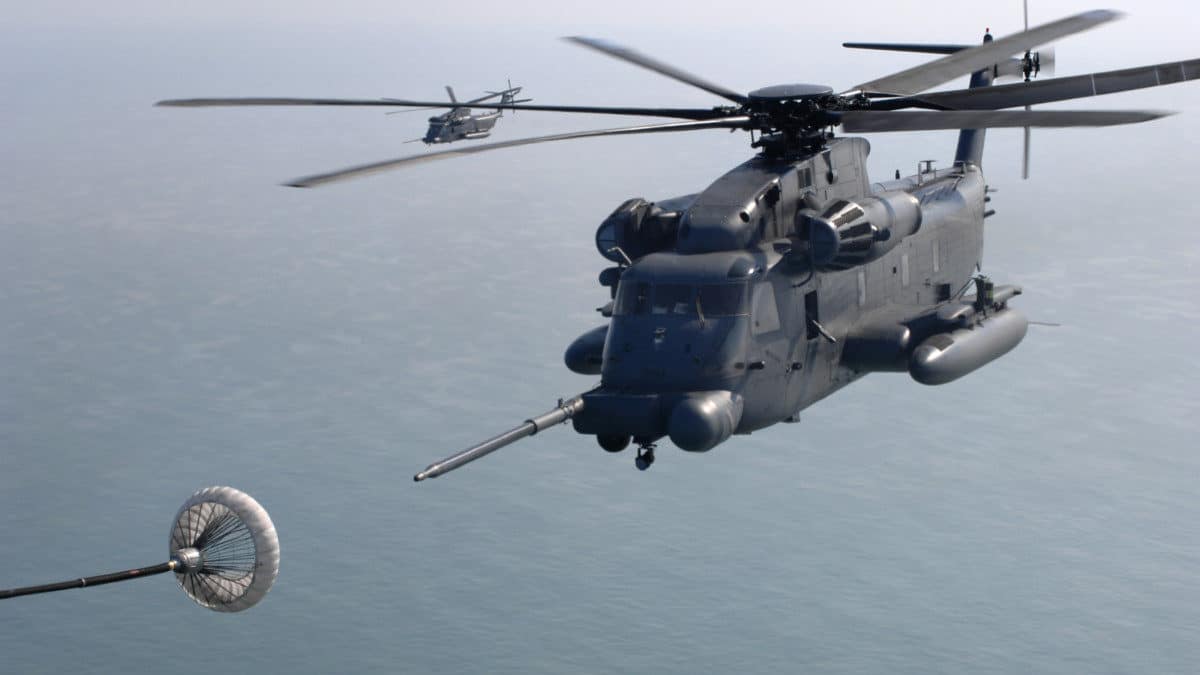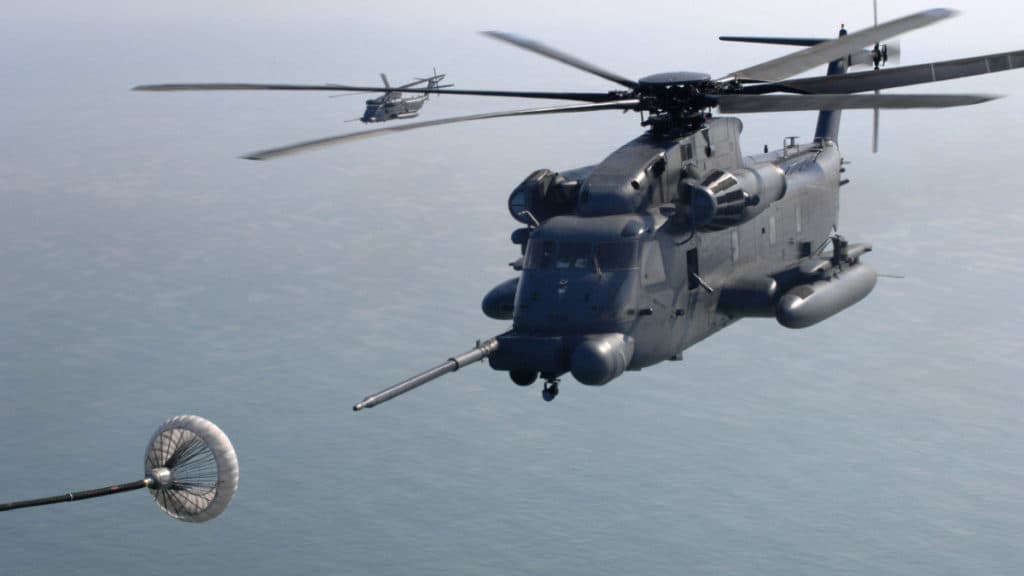
We have all seen the remarkable skill of the pilots of military jets refuelling while in flight behind an Airbourne tanker, but you may have seen some military helicopters now doing this too. There are many reasons why inflight refuelling is done for helicopters, but the questions are which helicopters and how do they do it!
Specially equipped military helicopters are able to refuel inflight from a fuel drogue towed behind an aerial tanker or by hovering next to a resupply ship over the ocean. Commercial and private helicopters are not able to refuel in flight due to the high risk and lack of market desire.
So what does it take to be able to fill a helicopter while in flight and why is it done? If these are just some of the questions you have, please read on…
Can Military Helicopters Refuel in Flight?
Common Military helicopters that can refuel inflight are V-22 Osprey, Pavehawk, Blackhawk, Super Stallions & Chinooks. Refuelling operations over water and hostile territory allow these helicopters to fly further and safer due to the lack of needing to land and refuel every couple of hours.
Aerial refuelling for helicopters has been around for decades and many of the helicopters designed for the military have been purposely designed to allow for air-to-air refuelling as part of the specifications demanded by the world’s military.
The main purpose of inflight refuelling is to extend the operating range of the helicopter and negate the need for it to land – Most of the time the helicopter is unable to land do the remoteness of where it is flying or because of the hostility of the area.
By refuelling while airborne it keeps the crews safe and allows for missions that would never be able to be completed because of fuel exhaustion. Now the only limiting factor is crew fatigue during a long flight.
For helicopters that are able to refuel inflight, there are two systems installed on the aircraft:
- A regular refuelling system to allow fuel to be loaded via ground-based fuel trucks. This can be either a pressurised or unpressurized delivery system depending on the size of the helicopter.
- A pressurized refuelling probe that mounts to the nose of the aircraft and can be extended to decrease collisions with the main rotor system during air-to-air refuelling.
Refuelling while in flight in a helicopter is a very high-risk operation due to the proximity of the delivery system to the helicopter’s main rotor system and that fuel is being delivered. Any contact between the main rotor system and the fuel delivery system can cause catastrophic damage to the main rotor system and lead to a fire from a leaking fuel delivery hose.
Here is a video of an inflight refuelling mishap that had a lucky outcome:
This happened because the air tanker caught a pocket of rising air causing the refuelling drogue to rise. The helicopter pilot had not yet connected into the drogue but the refuelling probe on the CH53 Sea Stallion was extended. The pilot overcontrolled probably due to panic and pulled aft on the cyclic causing the nose of the helicopter to pitch up to try and stay at the same altitude as the tanker.
Upon realizing they pitched up too far the pilot pushed forward on the cyclic to try and level off, however, this pulled the front of the rotor disk down while the nose of the fuselage was still pitched up and the contact was made severing the refuelling probe – A Vey lucky escape!
Refuelling inflight takes a lot of training, practice, a calm demeanour and smooth hands. I can tell you from experience that even trying to hold an aircraft in formation while flying is a tough task, let alone lining up to a drogue, in close proximity to a large aircraft creating wake turbulence and then holding it there for several minutes while onboarding fuel!
These are very good pilots! Doing it while flying an external load that turns you into a pendulum is just a whole other level!
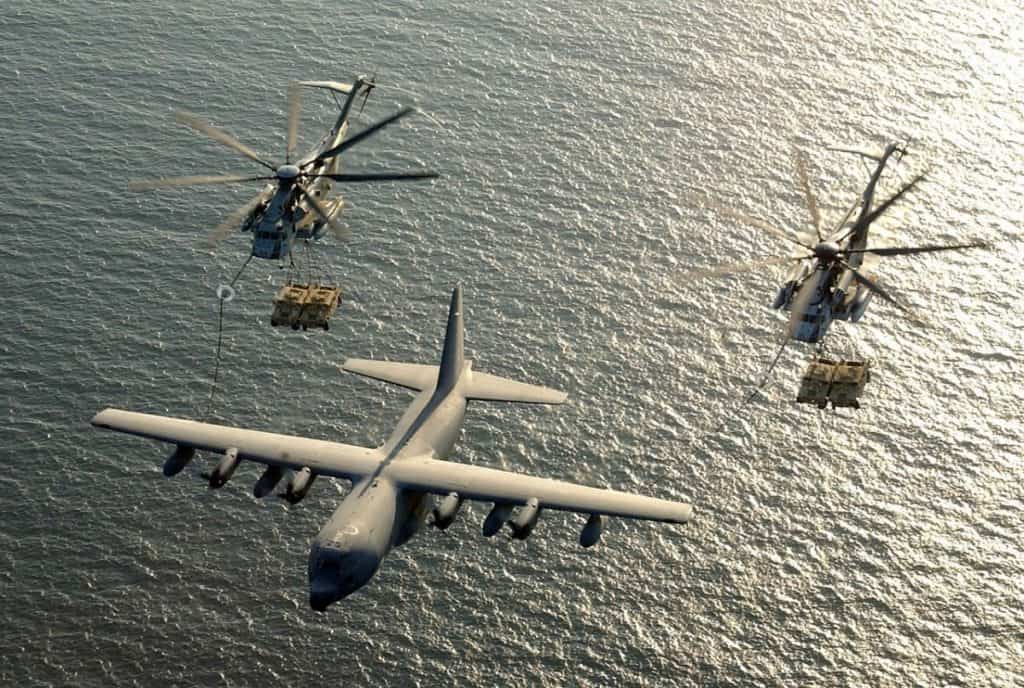
Learn More…
Try These Articles:
* What Is A Helicopter Blade Made of? It Used To Be Wood!
* How Much Fuel Does a Helicopter Burn? Get Your Visa Card Out!
How Do Military Helicopters Refuel in Flight?
Helicopters can either be refuelled while in cruise using a drogue delivery system towed behind an aerial tanker or by hovering next to a ship and a fuel hose is winched up and connected to the helicopter. Both systems use a pressurized delivery system to keep fuel contained and delivered rapidly.
Depending on the operation and equipment fitted to the aircraft will dictate which system can be used:
At Cruise
By far the most common way of helicopter air-to-air refuelling is by using the same platform their fixed-wing counterparts have been using. For helicopters, the only system that can be used at this time is the Drouge Delivery system.
A fuel hose is connected to a hose reel that the tanker crew unwind and trails behind the tanker when refuelling operations are to begin. To help prevent the end of the fuel hose from flapping around a drogue is attached to the end which acts like a parachute to create drag. This ensures the end of the refuelling hose flies smoothly behind the tanker.
Once cleared in to begin refuelling, the pilot usually comes up from behind and above the tanker to remain out of its wake turbulence. As the helicopter gets within a few hundred feet the pilot descends the helicopter to line up the refuelling nozzle on the front of the helicopter to align with the drogue.

Join My Newsletter & Get Great Tips, Information and Experiences To Help You Become a Superb Pilot!
The pilot needs to drive the refuelling nozzle into the drogue for it to mechanically attach and begin fuel delivery. Once connected the pilot will initiate a very slight climb to pull the drogue higher than the fuel line so that in the event of a disconnect the fuel hose will fall down and away from the helicopter’s main rotor system.
Fuel is usually dispensed around 250-400 gallons per minute depending on the setup. Depending on how much fuel is required a fuel stop can be completed in a matter of several minutes.
To disconnect the pilot pulls the helicopter out of the drought and the quick-release mechanism stops the fuel flow and allows the disconnect.
In Hover
Used by many naval helicopters the ability to transfer fuel to a helicopter that cannot land on a ship allows for the mission envelope to be dramatically increased. Some countries have even equipped their coast guard helicopters with the procedures and equipment to allow this type of refuel.
A helicopter will come to a hover over a moving vessel and drop its winch line down to the deck crew who attach a fuel line. The fuel line is winched up and connected to the helicopter’s fuel intake connector. The deck crew then initiate the fuel delivery while the pilots keep the helicopter stationary over the moving vessel.
During the refuelling, the helicopter side slips off the side of the boat to help eliminate the downwash on the deck crew and provide a safe area underneath the helicopter in the event of a fuel leak, hoist malfunction and aircraft malfunction.
This is a lot simpler than inflight refuelling mentioned above and requires far simpler equipment to be installed, if any.
After the required amount of fuel has been delivered the pilot will radio to the aircraft and deck crews who will stop the fuel flow and begin the disconnection and winching of the fuel hose back to the deck.
This type of operation allows for a helicopter to be refuelled from almost any large vessel in the Navy fleet.
Can Civilian Helicopters Refuel in Flight?
There are no civilian helicopters that can be refuelled in flight at this time. The need to do so and the high risk involved negate the requirement for companies to invest the money and time to equip their helicopters with the required technology. Civilian helicopters all land to refuel.
Most civilian helicopters are refuelled using an unpressurized fueling system. This is the same as your car where a fuel nozzle is inserted into a hole in the fuselage and fuel is pumped in. Fuel can leak out, especially when overfilled.
Pressurized fuel systems allow for a much faster fuel delivery that requires different connectors and pumps that are not required or fitted to 99% of civilian helicopters. To be able to safely deliver fuel to a helicopter in flight this sealed type of system would be required.
When a helicopter has landed it will be completely shut down as this removes the engines from being a source of ignition and 95% of civilian helicopters are refuelled this way. There are times though when helicopters are refuelled during Hot Refuels.
What is Aircraft Hot Refuelling?
Hot refuelling is when an aeroplane or helicopter is refuelled while the engine/s are still running. This allows for a quick fuel stop but needs to be completed under specified conditions with trained personnel and authority. Passengers are usually not allowed on board during filling.
For most helicopters, it takes anywhere from 30 seconds to 3 minutes to shut down and a further 30 seconds to 5 minutes to startup and be ready for liftoff. This time can cause extensive delays, especially under certain circumstances which I’ll explain in a moment.
To increase turnaround time pilots or personnel can refuel a helicopter while it is still running. In most cases, the helicopter will land next to the fuel pump and the pilot decels the aircraft to its idle speed. They will either then instruct ground personnel to begin fuelling or place control locks onto the flight controls, exit the helicopter and refuel the aircraft themselves.
It is usually only helicopters that use Jet fuel that is permitted to do this type of operation. Helicopters using AvGas I have never seen hot refuelled. Probably due to their fuel filler cap locations in proximity to the main rotor system and the volatility of gasoline.
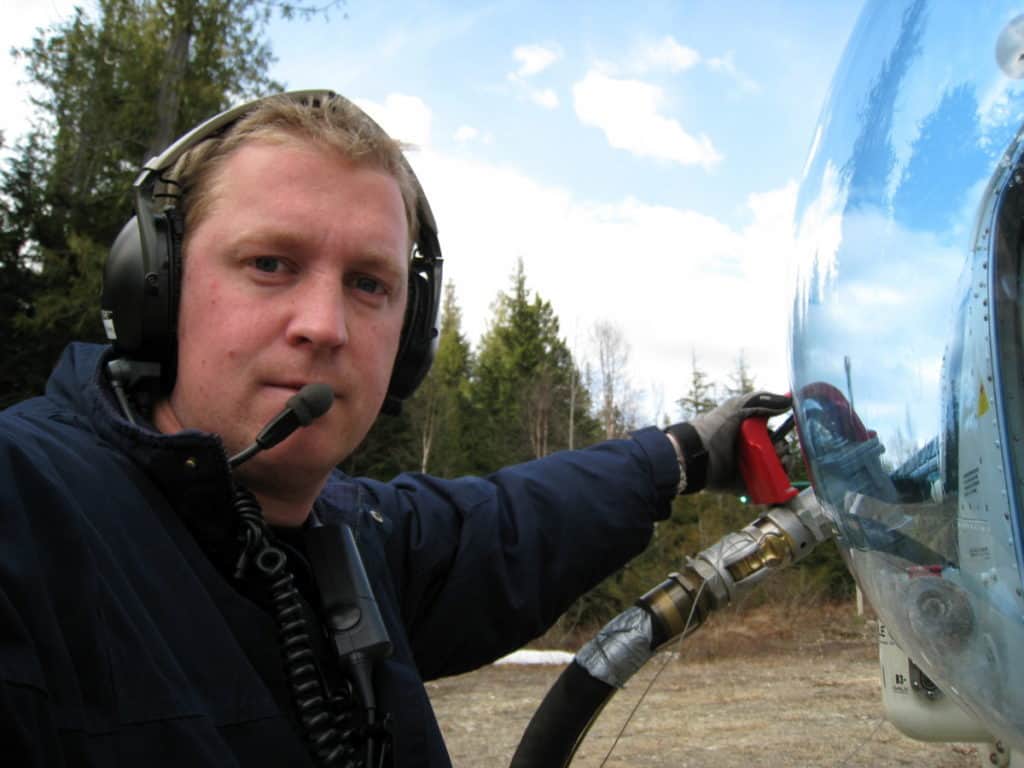
For most pilots or companies the need to save 5 minutes for a shutdown/startup never outweighs the much-increased risk that hot refuelling presents, especially if it is the pilot carrying out the fueling.
I have worked for many companies and some companies allowed it and some companies forbid hot refuelling, so it’s all dependent on where you work.
One of the most common places I have seen hot refuelling in action is on large campaign wildfires where there are dozens of helicopters constantly in and out of the fuel station. In situations like this, a fueling contractor will set up a fuel truck so helicopters can land around and certified personnel will instantly approach and begin fuelling.
This allows for quick stops and prevents a traffic jam at the fuel station. Not all fire agencies allow this, especially since an incident where a refueler was filling a helicopter and slipped off their ladder spraying fuel into the engine intake of the running helicopter.
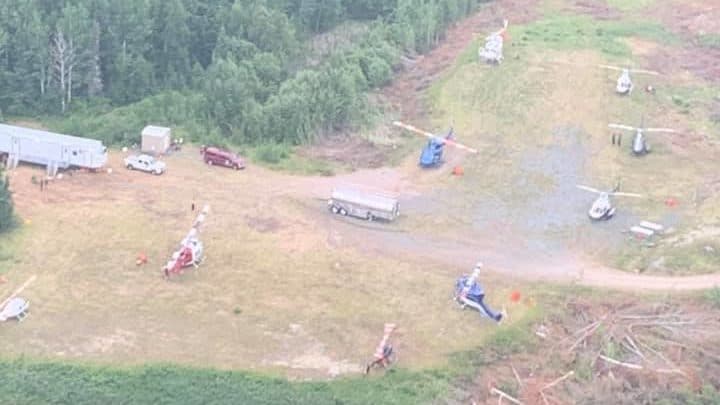
This caused an intense fire which destroyed the helicopter and shut down the fuelling station. No one was hurt but a simple slip caused expensive consequences!
Learn More…
Try These Articles:
* What Fuel Do Aircraft Use? – Same As Your Car???
* Helicopters – How are they used to fight wildfires?

